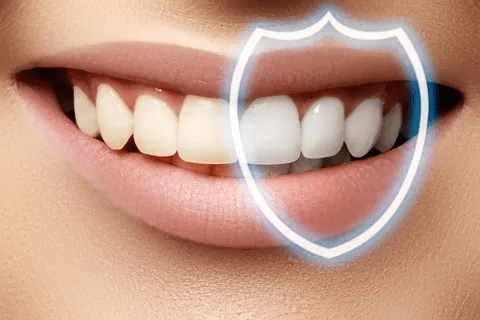Are you tired of feeling embarrassed about your discolored teeth? Have you considered professional teeth whitening as a solution? It’s a safe and effective way to brighten your smile and boost your confidence.
However, with so many different methods and prices available, it can be overwhelming to decide which option is best for you. Don’t worry. In this post, we’ll explore the exciting world of professional cosmetic teeth whitening and help you find the perfect fit for your lifestyle and budget.
PROFESSIONAL WHITENING METHODS
In-office professional teeth whitening procedures are typically carried out over a series of short appointments tailored to meet your individual requirements. During these sessions, a potent whitening agent is applied in increments lasting 15 to 30 minutes each, with the entire treatment usually concluding within approximately an hour and a half.
Several methods are employed in in-office whitening treatments, including:
1. HIGH CONCENTRATION HYDROGEN PEROXIDE GEL APPLICATION
Gingivitis leads to plaque accumulation at the gum line, which is considered the primary cause of bleeding gums. If not removed, this condition eventually evolves into inflamed gums, where gums become dusky, swollen, and frequently bleed while brushing. If not treated immediately, gingivitis can also lead to severe gum disease, which then contributes to tooth loss.
2. HYDROGEN PEROXIDE COMBINED WITH HIGH-INTENSITY LIGHT
Another approach combines hydrogen peroxide with a high-intensity light source, such as LED, UV, or halogen. The light is emitted by a lamp or laser device strategically positioned just outside your mouth.
These in-office procedures aim to provide efficient and noticeable teeth whitening results. The choice of method may depend on factors such as your preferences and the recommendations of your professional dentist.
WHAT TO EXPECT
When you undergo in-office teeth whitening, the process typically involves several key steps:
1. ASSESSMENT OF CURRENT TOOTH SHADE
Your dentist will use a tooth shade chart to determine the current color of your teeth. Together, you will discuss the expected improvement in shades after the whitening procedure.


2. PREPARATION AND POLISHING
Using a pumice tool, your dentist will polish your teeth to eliminate any remaining plaque and ensure a clean surface for the whitening treatment.
3. PROTECTIVE MEASURES
To prevent the whitening agent from coming into contact with sensitive areas like gums, cheeks, or tongue, your dentist will use tools to keep your mouth open. And place a protective barrier along the gum line.


4. APPLICATION OF WHITENING AGENT
The whitening agent is applied and left on for up to an hour. If light activation is part of your treatment, it is applied during this stage. If additional coats are required, your dentist will reapply the whitening agent accordingly.
5. RINSING AND FLUORIDE APPLICATION
After the whitening process, your mouth is rinsed, and your dentist may apply fluoride to help minimize potential sensitivity.


6. DISCUSSION AND POST-WHITENING CARE
At the end, you and your dentist will discuss whether your teeth have reached the desired shade. Your dentist will provide guidance on lifestyle habits, including avoiding brightly colored foods, coffee, and red wine. Immediately after whitening, your teeth are relatively more susceptible to stains from liquids and foods.
Moreover, it’s important to note that, even if you follow your dentist’s recommendations, your teeth may appear slightly darker a few days after whitening. This is normal, and adherence to post-whitening care is essential for optimal results.
COSTS
Here’s a breakdown of the most common professional and over-the-counter (OTC) teeth whitening methods, considering factors like cost, peroxide level, duration, maintenance, sensitivity, and results:
1. TOOTHPASTE AND MOUTHWASH
- Cost: $3 – $30
- Peroxide Level: Up to 5%
- Duration: 2 minutes (toothpaste) and 60 seconds (mouthwash)
- Maintenance: Daily or a few times a week
- Sensitivity: Low, Temporary
2. STRIPS
- Cost: $8 – $60
- Peroxide Level: 3 to 10%
- Duration: 30 minutes per session
- Maintenance: A few times a month
- Sensitivity: Moderate, Temporary
3. DENTAL KITS
- Cost: $20 – $50
- Peroxide Level: 10 to 20%
- Duration: 10 to 45 minutes per session
- Maintenance: A few times a month
- Sensitivity: Moderate, Temporary
4. IN-OFFICE BLEACHING
- Cost: $500 – $1,000
- Peroxide Level: 25 to 40%
- Duration: 40 to 60 minutes per session
- Maintenance: Every 6 months to 1 year
- Sensitivity: Moderate, Temporary
5. LASER WHITENING
- Cost: $500 – $1,000
- Peroxide Level: 25 to 40%
- Duration: 30 to 60 minutes per session
- Maintenance: Every 6 months to 1 year
- Sensitivity: Low, Temporary
Consider these details to choose the teeth whitening method that aligns with your preferences, budget, and desired results.
KEY TAKEAWAY
Professional teeth whitening offers a diverse range of methods catering to individual preferences and budgets. In-office procedures involving high-concentration hydrogen peroxide gels or the combination with high-intensity lights. They usually deliver efficient and noticeable results within relatively short sessions.
Understanding the costs and characteristics of various professional and over-the-counter whitening methods empowers individuals to make informed choices. While at-home options like toothpaste, strips, and dental kits offer affordability, in-office treatments, such as bleaching and laser whitening, provide longer-lasting results with higher concentrations of whitening agents.
Ultimately, achieving a brighter, more confident smile involves a balance between personal preferences, financial considerations, and the commitment to post-whitening care. With these insights, individuals can opt for the methods that align with their preferences and acquire the desired results.










